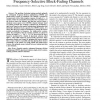Free Online Productivity Tools
i2Speak
i2Symbol
i2OCR
iTex2Img
iWeb2Print
iWeb2Shot
i2Type
iPdf2Split
iPdf2Merge
i2Bopomofo
i2Arabic
i2Style
i2Image
i2PDF
iLatex2Rtf
Sci2ools
TIT
2002
2002
Optimal placement of training for frequency-selective block-fading channels
The problem of placing training symbols optimally for orthogonal frequency-division multiplexing (OFDM) and single-carrier systems is considered. The channel is assumed to be quasi-static with a finite impulse response of length ( + 1) samples. Under the assumptions that neither the transmitter nor the receiver knows the channel, and that the receiver forms a minimum mean square error (MMSE) channel estimate based on training symbols only, training is optimized by maximizing a tight lower bound on the ergodic training-based independent and identically distributed (i.i.d.) capacity. For OFDM systems, it is shown that the lower bound is maximized by placing the known symbols periodically in frequency. For single-carrier systems, under the assumption that the training symbols are placed in clusters of length (2 + 1), it is shown that the lower bound is maximized by a family of placement schemes called QPP- , where QPP stands for quasi-periodic placement. These placement schemes are formed...
| Added | 23 Dec 2010 |
| Updated | 23 Dec 2010 |
| Type | Journal |
| Year | 2002 |
| Where | TIT |
| Authors | Srihari Adireddy, Lang Tong, Harish Viswanathan |
Comments (0)

